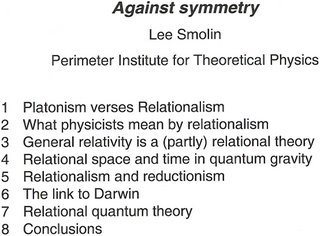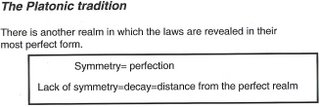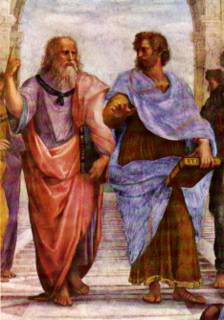Time is of your own making;See Status of Warp Drive Smolin had some deep questions and relevance "about" time? :)
its clock ticks in your head.
The moment you stop thought
time too stops dead. Angelus Silesius
Some "updates" within this article. Mainly for all those "couch potatoes" who watch Law and Order. I remembered Sean Carroll's portrayal as well on Preposterous Universe when Clifford showed the picture from "the lecture" Clifford is showing today.
 Dark Matter and Dark Energy: from the Universe to the Laboratory-Conclusion
Dark Matter and Dark Energy: from the Universe to the Laboratory-Conclusion See comment here
Good show
Are Cosmologists Couch Potatoes?
Your asking for simplicity and without a geometrical/topological approach(quantum gravity), the cosmos from surveillance and interrogation, and without further introspection, it leaves one with a nice comfortable view, as is.
That's nice, for those who want to sit back and watch the show:)
That fellow, does he have his binoculars backwards!Hmmmmm:)How would this lensing affect his view of the stake out? So close, yet so far away?
plato | Homepage | Mon, February 21, 2005 @ 3:22 pm | #
Maybe Clifford is a Seer? Or, is he a Craftsman who became a seer, like Lee Smolin? Well, we'd have to delve into the reason a seer "became" or could possibly "become?"
The Craftsman

BEHOLDING beauty with the eye of the mind, he will be enabled to bring forth, not images of beauty, but realities, for he has hold not of an image but of a reality, and bringing forth and nourishing true virtue to become the friend of God and be immortal, if mortal man may. Would that be an ignoble life? PLATO
If one had given their whole life to rote and memorization, how much smarter would they be, if they did not allow themselves to be "filled?" It is as if the universe said "look at the emptiness. This cannot be so?" It was at that moment the mind fills with all these "wonderful things" as if all that had taken place was ignited into a new view of the world. It is literally not the same world for them?
 Tabula rasa (Latin: scraped tablet or clean slate) refers to the epistemological thesis that individual human beings are born with no innate or built-in mental content, in a word, "blank", and that their entire resource of knowledge is built up gradually from their experiences and sensory perceptions of the outside world. See Tabula rasa: The Glass Room
Tabula rasa (Latin: scraped tablet or clean slate) refers to the epistemological thesis that individual human beings are born with no innate or built-in mental content, in a word, "blank", and that their entire resource of knowledge is built up gradually from their experiences and sensory perceptions of the outside world. See Tabula rasa: The Glass Room Predictions? Every tone spoken as if this new change took place, realized, that having enter a part of reality that was somehow away from, yet, existed in the reality until discovered. Coxeter shared these same views? So, every kind of geometry you know of, already exists, and is just waiting to be discovered. You had to be able to tap into the probabilities. You were always preparing the stage.
Timaeus:
 Genesis Timaeus 27c-34a
Genesis Timaeus 27c-34aFirst then, in my judgment, we must make a distinction and ask, What is that which always is and has no becoming; and what is that which is always becoming and never is? That which is apprehended by intelligence and reason is always in the same state; but that which is conceived by opinion with the help of sensation and without reason, is always in a process of becoming and perishing and never really is. Now everything that becomes or is created must of necessity be created by some cause, for without a cause nothing can be created.See Timaeus:Laying the Ground rules on Genesis
The Mechanism
 See "The Cosmological Constant and the String Landscape by Joe Polchinski (UCSB, KITP)"
See "The Cosmological Constant and the String Landscape by Joe Polchinski (UCSB, KITP)"So one has to take into account the perspective being developed by others before we get to where we have some kind of mechanism of tunnelling the landscape? Is it right or not, to have a "potential hill" have evidence of some kind, having been traverse? You would then think, hmmm... the blackhole as a horizon?
Three Ring Circus: Dark Energy
"Of course this information is based on 2003 data but the jest of the idea here is that in order to go to a "fast forward" the conditions had to exist previously that did not included "sterile neutrinos" and were a result of this "cross over."
What reason did Lee Smolin called the string theorists craftsman? I think part of the fun for me is when somebody who sits out front in terms of being a science director of a kind, then one is immediately thinking "okay, why did he say this."
 See The Entropic Principle by Raphael Bousso (UC Berkeley)
See The Entropic Principle by Raphael Bousso (UC Berkeley) Now, why did he say that? Yes, it would be easier to go to him and get the reason right from the person's mouth. But hey their busy, and I do not want to be on the list of those knocking on doors being pesky. Besides, that's part of the fun of doing the detective work and trying to understand the basis of any argument they may have.
The Demiurge (Creator)
Literally, “craftsman.” The creator of Plato’s physical world is not a divine intelligence or a personal ruler, but (as it were) a manual laborer. Cf. Vlastos, Plato’s Universe (pp. 26-27):
That the supreme god of Plato’s cosmos should wear the mask of a manual worker is a triumph of the philosophical imagination over ingrained social prejudice. ... But this divine mechanic is not a drudge. He is an artist or, more precisely, what an artist would have to be in Plato’s conception of art: not the inventor of new form, but the imposer of pre-existing form on as yet formless material.
The Seer
So we now know to a degree how Lee Smolin assigned the Craftsman, but little is said about the Seer? The Seer, is one who knows how to use that blank slate. Knows how to find the departure point and is asking to be filled?
If there are any runners out there, you might know the "depletion point" one can reach after having expended the energy, one gains a sense of this new influx of energy and well being? Having once know these times in my youth, I am sad to say, I am to old to be ever running like I did.
So one sees the community is suffering and leaders in despair as to how new ideas can be generated and new ways to invigorate science come to the forefront. Is the privileged few who see themself pertaining to some model, that one would now say, hey they are getting all the incentives and the idea here about nurture is suffering?
No, there must be special way to invigorate the scientists of the future? Allow them to empty themselves after the intense involvement, to allow the mind, when empty to be filled?
(Thanks Bee for asking the question By the way, "Happy Easter" to you and Stefan)




